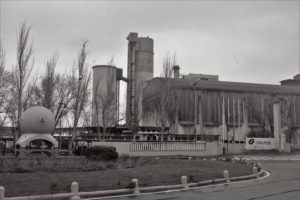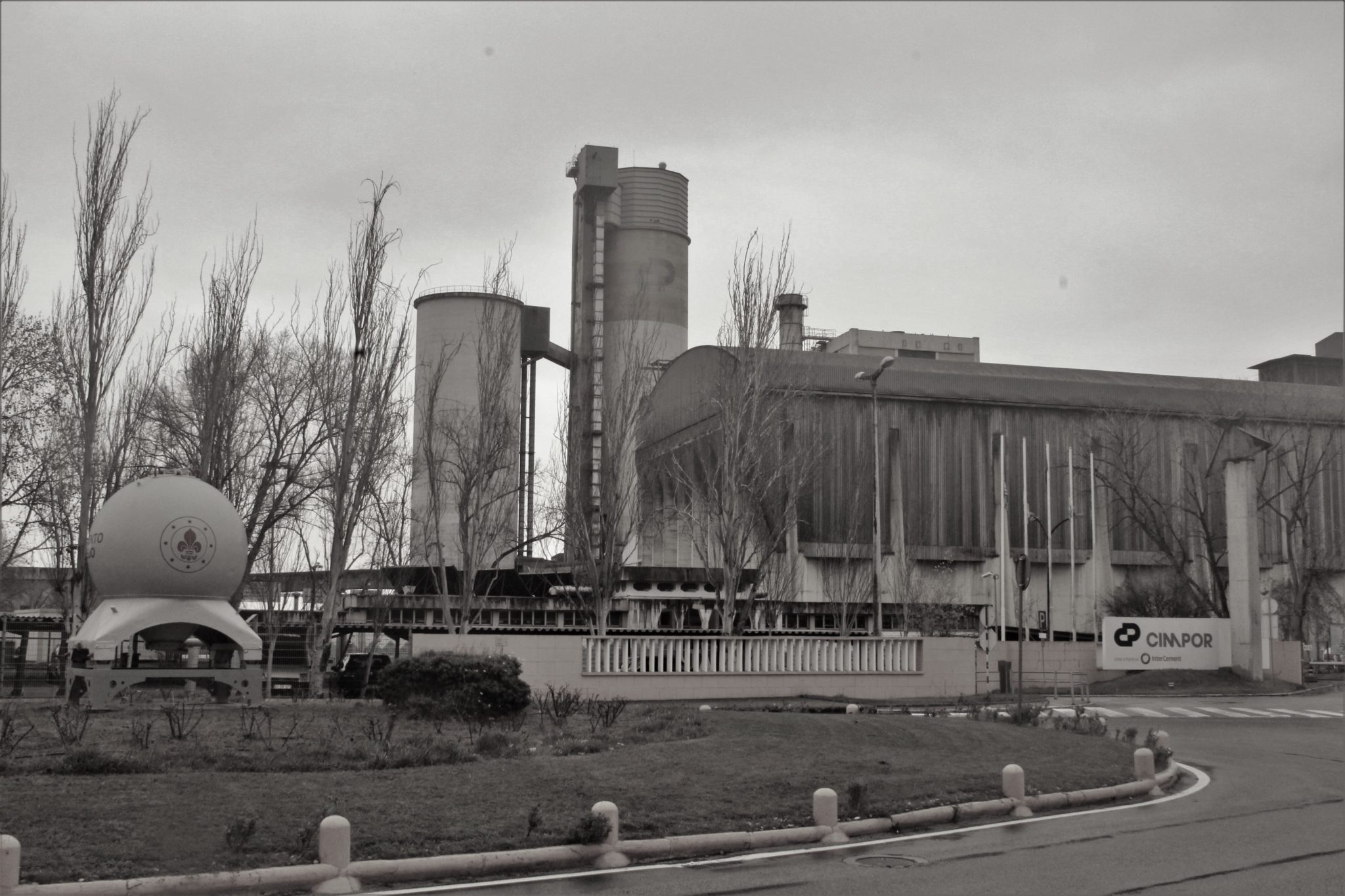Fundada em 1976, a Cimpor assume-se como um dos 10 maiores grupos cimenteiros a nível mundial e emprega mais de 9000 pessoas em 8 países, entre os quais Portugal, Moçambique e Brasil. Em território nacional a cimenteira tem três fábricas: uma das quais localizada em Loulé no distrito de Faro, outra em Souselas no concelho de Coimbra e uma última em Alhandra no concelho de Vila Franca de Xira. Em termos financeiros a empresa só no ano de 2016 teve prejuízos na casa dos 700 milhões de euros, número 10 vezes maior ao registado no ano anterior: a queda de cerca 35% de negócio no mercado brasileiro é apontado como o principal responsável. Ainda assim, a produção em Portugal não para e a exportação assume-se como o principal destino de grande parte do cimento produzido a nível interno.

A unidade fabril de Alhandra é uma das principais entidades empregadoras da região / The factory in Alhandra is one of the main employers in the region
A fábrica em Alhandra, vila pertencente ao concelho de Vila Franca de Xira, assume-se como a maior do grupo em Portugal e é uma das principais imagens de marca e fonte de dinamismo económico desta vila às portas de Lisboa. Mas a sua atividade tem sido alvo de várias críticas e descontentamento por parte dos moradores que se queixam frequentemente dos maus cheiros e da poeira causada pela operação da Fábrica. “ Há dias em que o ar é irrespirável e por isso nem podemos abrir as janelas, já para não falar da roupa que está estendida e que fica toda suja com a poeira”, afirmou Irene Fernandes, a morar em Alhandra há mais de 20 anos, em janeiro deste ano.
O sentimento de preocupação é partilhado por grande parte dos moradores que têm ainda bem vivo na memória o surto de “legionella” que afetou o concelho em 2014 e que atingiu 375 pessoas e fez 12 vítimas mortais: “Uma pessoa já nem sabe se é seguro sair à rua quer para nós quer para os nossos filhos e se, sem saber, está a apanhar uma doença qualquer que se pode tornar grave como aconteceu em 2014 aqui no concelho”, sublinhou Maria Mata que há já muito tempo sente a poeira causada pela fábrica no pára-brisas do seu automóvel.
Um estudo da associação ambientalista “Zero” do ano de 2017 (que pode ser conhecido mais a fundo neste link) aponta a unidade fabril da Cimpor em Alhandra como a quinta mais poluente do ar a nível nacional segundo dados do Registo de Emissões e Transferências de Poluentes”. Segundo o mesmo estudo, que aponta a central termoelétrica em Sines como a mais poluente do país, os resíduos mais frequentemente emitidos são o dióxido de carbono, mercúrio e, entre outros, fluoretos.
Apesar das várias críticas da população e já várias reclamações tanto à empresa como ao município, o cenário mantém-se o mesmo e as partículas de poeiras no ar e maus cheiros continuam a ser recorrentes. Neste sentido um morador criou uma página no facebook intitulada de “Chega de Poluição em Alhandra” que já soma mais de 400 gostos e que partilha fotos e vídeos nos quais são visíveis a poeira provocada pela chaminé da fábrica.
Em todas as abordagens por parte da comunicação social, nomedamente à Agência Lusa, a Cimpor garante “cumprir todos os requisitos legais” e acrescenta dizendo que todas as emissões resultantes da operação da fábrica são “permanentemente monitorizadas, através de equipamentos certificados por entidades externas à Cimpor e acreditadas para o efeito”. Ainda assim, a poluição resultante da ação da fábrica continua a ser visível e os moradores de Alhandra esperam medidas urgentes por parte do executivo camarário e até mesmo do governo central.
Founded in 1976, Cimpor is one of the 10 largest cement companies worldwide and employs more than 9,000 people in 8 countries, including Portugal, Mozambique and Brazil. In the national territory the cement factory has three factories: one is located in Loulé in the district of Faro, another in Souselas in the county of Coimbra and one last in Alhandra in the municipality of Vila Franca de Xira. In financial terms, the company only had losses of 700 million euros in 2016, a figure 10 times higher than in the previous year: the fall of around 35% in the Brazilian market is considered the main culprit. Even so, production in Portugal does not stop and the exportation is assumed as the main destination for much of the cement produced domestically.
The factory in Alhandra, a village in the municipality of Vila Franca de Xira, is the largest of the group in Portugal and is one of the main images of brand and source of economic dynamism of this village at the gates of Lisbon. But its activity has been the subject of several criticisms and discontent on the part of the residents who often complain of the bad smells and the dust caused by the operation of the Factory. “There are days when the air is unbreathable and therefore we can not open the windows, let alone the clothes that are stretched and that is all dirty with dust,” said Irene Fernandes, living in Alhandra for more than 20 years , in January of this year.
The feeling of concern is shared by a large part of the residents who still have alive in memory the outbreak of “legionella” that affected the county in 2014 and which reached 375 people and made 12 victims: “A person doesn´t even know if it is safe to go out on the street for us or for our children and if, without knowing, it is catching any disease that can become serious as happened in 2014 here, in Alhandra”, stressed Maria Mata who has long felt the dust caused on the windscreen of your car.
A study by the environmental association “Zero” of 2017 (which may be known more in depth on this link) points to Cimpor factory in Alhandra as the fifth most polluting air at national level according to data from the “Register of Emissions and Transfers of Pollutants”. According to the same study, which points to the thermoelectric factory in Sines as the most polluting in Portugal, the most frequently emitted waste are carbon dioxide, mercury and, among others, fluorides.
Despite the various criticisms of the population and already several complaints to both the company and the municipality, the situation remains the same and the dust particles in the air and bad smells continue to be recurrent. In this sense a resident created a page on facebook titled “Enough of Pollution in Alhandra” that already adds more than 400 likes and that shares photos and videos in which are visible the dust caused by the chimney of the factory.
In all approaches by the media, namely to the Lusa Agency, Cimpor guarantees to “comply with all legal requirements” and adds saying that all emissions resulting from the operation of the plant are “permanently monitored, through equipment certified by entities external to the Cimpor and accredited for this purpose.” However, the pollution from the factory is still visible, and residents of Alhandra are expecting urgent action from the city’s executive and even of the central government.




You must be logged in to post a comment.